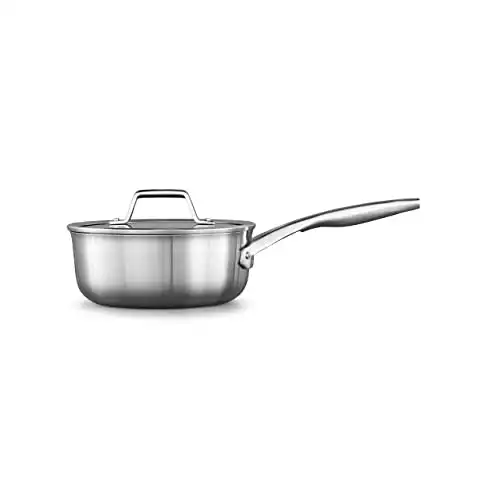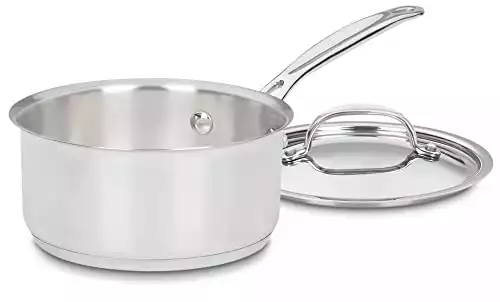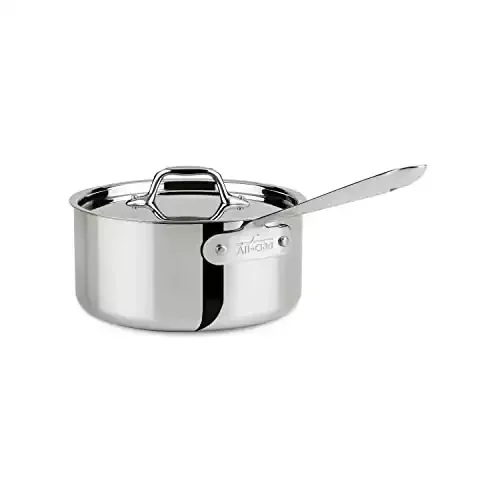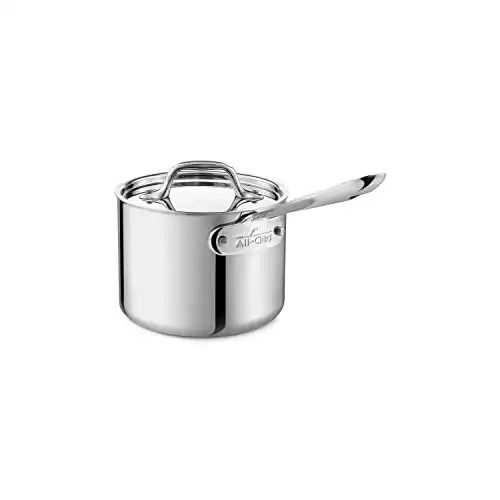A small saucepan is incredibly versatile and likely to get more use than most pots and pans in your home kitchen. After years as a professional chef, it’s certainly become one of the most essential cookware pieces in mine.
In this article, I’ll share the basic principles you should follow when choosing a saucepan for your kitchen. I will also provide a few of my favorite products for different budgets.
From the most affordable to the top of the line, I’ll teach you how to choose the best saucepan for your cooking style, size requirements, and other concerns, based on my years of experience in home and professional kitchens.
In This Article
Our Top Picks
- Performs well above its price tag
- Rounded “corners” are ideal for stirring and whisking
- Excellent materials and construction
- Very inexpensive
- Rolled rims for drip-free pouring
- Induction Compatible
Best Overall: Calphalon Premier 2.5-Quart Saucepan
The Calphalon Premier saucepan looks and performs like a top-end brand but costs three or four times less.
The thing I love the most about this saucepan is the rounded design of the base. It almost eliminates the “corners” that you tend to find in most saucepans. This makes stirring and whisking easier and you never miss the ingredients that normally get stuck in those corners.
The steel and aluminum construction of this pan is going to heat evenly for everyday cooking. The pan sides are made by an aluminum core that is sandwiched between two layers of stainless steel.
This tri-ply pan base is fully clad, meaning that all three layers of metal extend up the sides of the pan. This is in contrast with some other products that are only clad on the pan’s bottom – a feature that creates a big improvement on how a stove distributes even heat.
The interior layer of stainless steel provides excellent durability and is non-reactive. That means you never have to worry about rust or the ingredients that you’re cooking with. The exterior layer adds more durability and is also magnetic so it’s ready for induction cooking.
The aluminum core provides excellent heat conduction. This helps your pan heat quickly and evenly from the base, all the way up to the rim. Ingredients will cook evenly, and you won’t have to wait long when you adjust the temperature of the stove.
The accompanying lid is made from tempered glass so that you can easily monitor food while cooking. And the stainless steel handles do a good job of staying cool on the stovetop.
This pan is oven safe up to 450 F. That’s not industry-leading, but it’s hot enough for just about any task you might need. It is also dishwasher safe, but handwashing will keep your cookware looking newer, longer.
Most home cooks won’t be able to tell the difference in performance between the Calphalon Premier saucepan and a premium-priced competitor.
What we like
- Performs well above its price tag
- Rounded “corners” are ideal for stirring and whisking
- Excellent materials and construction
What We don’t
- The lid can get water and grease stuck in its rim
Best Value: Cuisinart Chef’s Classic 1.5-Quart Saucepan
The Cuisinart Chef’s Classic saucepan doesn’t have many bells or whistles. But it also costs less than $20 and can handle most cooking tasks you throw at it.
This saucepan is disc clad rather than fully clad, and that’s where the big cost savings come in. That means that the multi-layered base has an aluminum core for better heat conductivity, but the sides of the pan are only a single layer of stainless steel.
The disc-clad base will provide good heat distribution to the bottom of the pot, but not up the side like the fully clad options.
The very bottom of this pan is made from magnetic stainless steel and can be used with any type of cooktop, including induction.
The included lid is also made from stainless steel, which I prefer for durability, but it means you won’t be able to monitor food while it’s covered.
The whole thing is dishwasher safe, and also oven safe up to 500 F. That’s hot enough for all of your cooking needs and is even higher than my “best overall” pick.
When it comes to tasks like boiling water, and heating up soups and sauces, this little pot will get the job done. If you cook a lot of grains or delicate sauces, you would probably benefit from the insulation and more even heating of a fully clad saucepan.
What we like
- Very inexpensive
- Rolled rims for drip-free pouring
- Induction Compatible
What We don’t
- Disc cladding doesn’t distribute heat up the sides
- Dishwashing can cause rust around the handle rivets
Best Upgrade: All-Clad D3 2-Quart Saucepan
I swear by All-Clad’s D3 cookware for even heat distribution and durability. I’ve used the line extensively in restaurants, and it has become my go-to at home.
The All-Clad D3 saucepan is fully clad, tri-ply cookware. The interior and exterior are durable stainless steel, and the core is a thick layer of aluminum. The core distributes heat excellently from the base to the rim. It also does a great job of quickly reacting to temperature changes.
The lids are stainless steel as are the stay cool handles. The unique contoured handles can take a little getting used to. But, once you do it offers better grip than most choices on the market, especially when it comes to pouring things from the pot.
The saucepan can be used in ovens up to 600 F. That’s hotter than most on the market and allows you to go from stovetop to oven without worrying about any damage or warping. While dishwashing it won’t ruin the pot, All-Clad recommends handwashing in order to keep it looking like new.
My “best overall” pick offers similar cooking performance for three times less. That can make it difficult to justify this purchase. But in my experience the build quality and overall durability of All-Clad is unmatched.
Other Options That Are Great But Didn’t Make The Cut
Mauviel 1.9-Quart M’Heritage Copper Saucepan
Mauviel’s copper saucepan with stainless steel interior is beautiful to look at and functional to cook with. This pan is expensive but if it’s in your budget it’s an excellent choice. It was actually my top pick for best copper cookware. The reason it didn’t make the top of the list here is that it requires some special maintenance and may not be the best all-purpose saucepan for more casual cooks.
Farberware Classic 2-Quart Saucepan
This is a great and inexpensive choice that may look a little outdated but always gets the job done. My mom has been using a pot just like this for as long as I can remember. It features an induction-ready stainless steel base with an aluminum core for even heating. The sidewalls are a single layer of steel as is the unique bell-shaped lid. The saucepan can only be used in the oven up to 350 F. That is definitely on the low side and one of the reasons it wasn’t picked as the Best Budget choice.
Buyers Guide: Choosing The Best Saucepan
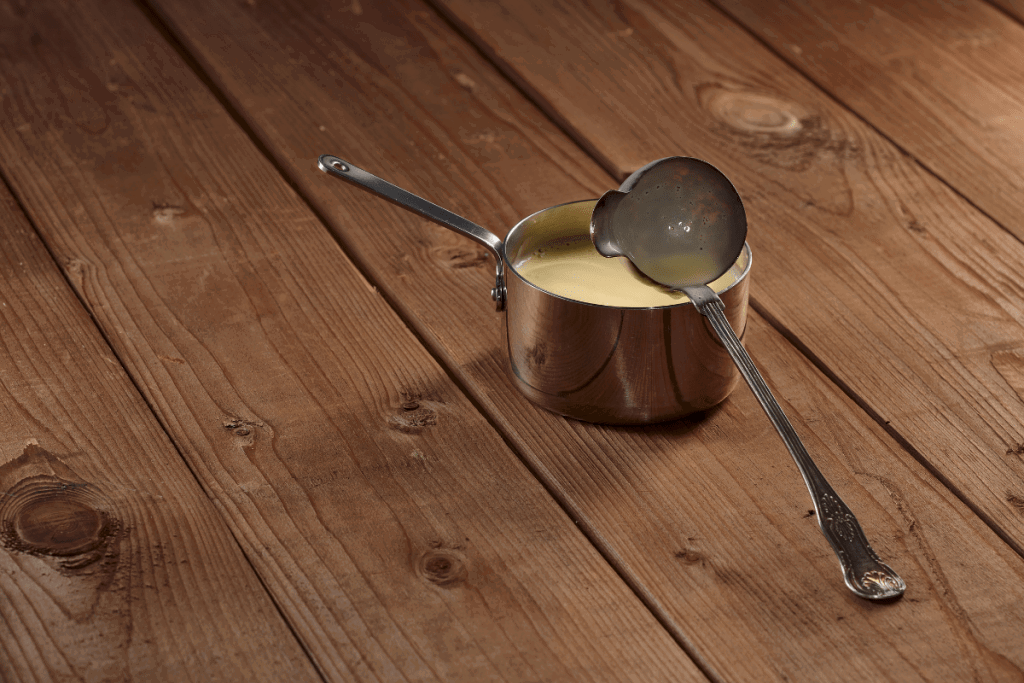
Material Choices And How Much Each Will Cost
For most situations, stainless steel is the way to go when it comes to choosing the best saucepan. It’s durable, non-reactive, and can be found at a wide range of prices.
Fully clad saucepans have multiple layers of metal throughout the pan and are the best when it comes to durability and heat distribution. This is my preferred choice for most stainless steel cookware. Be prepared to spend anywhere from $50 to around $200 for a 2-quart saucepan.
Disc cladding is the more affordable way to go. This choice will have a multi-layered base, usually with an aluminum core for better heat conductivity. The pan walls are made from a single layer of metal so there isn’t much heat distributed up the sides. You can find options like my Best Budget pick for less than $20 and I wouldn’t recommend spending more than $50.
Solid copper or copper core saucepans will provide the best heat conductivity. You will have to put in a little extra work when it comes to cleaning them and don’t expect to spend less than $200 for a good 2-quart model.
You can also go with a nonstick saucepan. These are generally made from aluminum with a nonstick coating and are priced similarly to disc-clad options. They are easy to clean but I generally avoid non stick options because you can’t use metal spoons, and they generally lack durability.
Size Considerations
Sizes range from .5-quarts up to around 4-quarts. Anything above that and you’re in stockpot or Dutch oven territory.
The best size for the widest range of uses is between 2 and 3-quarts. If I could only have one I would choose a 2-quart model, and I usually cook for between two and four people. That size allows you to cook small amounts of soups or sauce, but enough rice for up to six.
If you regularly cook for a large number of people consider sizing up to a 3 or 4-quart model. Just remember that the larger size will make it less useful for small amounts of food.
If you only cook for one or two people I would still go with a 1.5 or 2-quart saucepan to get the most uses out of one piece of cookware.
Handles & Lids
Stainless steel handles are the most common whether you’re looking at budget or top-of-the-line saucepans. These handles look good, and are almost always safe to use in the oven.
You can also find handles made from heat-resistant plastics. Bakelite and Phenolic handles are two common choices. These options are comfortable and inexpensive but they can break and often have lower oven temperature ratings.
A less common handle choice is cast iron. This is often reserved for copper saucepans. Cast iron handles look very nice but they must be oiled or waxed to keep from rusting.
Lids are almost always either stainless steel or tempered glass. Stainless steel lids are generally more durable, but you can’t monitor food with them on and they can be more expensive to buy or replace.
With a glass lid, you can view your food as you cook. The downside is that they can break and food or water can get stuck in their metal rims.
Heat Source And Useability
Just about any saucepan will work well on a gas or electric range. If you cook with an induction cooktop there are a few more considerations to keep in mind.
Most fully clad or disc-clad stainless steel saucepans can be used on any type of cooktop including induction.
Aluminum saucepans are not compatible with induction unless they have a magnetized base. And saucepans with a copper exterior are never induction compatible.
Fortunately, if you aren’t sure, there are a few easy steps you can follow to determine if your cookware is induction compatible.
My Recommendations
The Calphalon Premier tri-ply saucepan strikes the perfect balance of affordability and performance. Most owners agree that this cookware outperforms its price tag by a long shot. It will quickly become a pan that you reach for when preparing most meals.
If it’s in your budget, All-Clad’s D3 saucepan is an impressive piece of cookware and my personal favorite. Not only does it provide excellent heat distribution but its durability has been proven in top-end restaurants around the world.
If you’re not sure if a stainless steel pan is the best choice for your kitchen, take a look at our guide to the best cookware materials.
FAQs
What Are The Advantages Of Using A Saucepan?
A saucepan is essential in the kitchen because it is one of the best multitaskers around.
Besides sauteing, a saucepan can handle just about any cooking task you can throw at it. It’s my pan of choice for simple tasks like boiling eggs and making rice. But it can also be used for delicate sauces or pastry work.
The wide range of sizes available further adds to the saucepan’s versatility.
Yes, you could get an individual pan or appliance (like a rice cooker) for each unique function you want to perform. Or you can do it all with a single piece of cookware, and sometimes that is just more convenient.
What Are The Common Drawbacks Of Using A Saucepan?
Saucepans are best for recipes that call for a high percentage of liquid. When it comes to things like searing and sautéing, the small cooking surface and high side walls trap too much moisture. That makes it very difficult to achieve a good level of caramelization and things tend to get soggy before they are nicely browned.
Saucier Vs. Saucepan: Do I Need Both?
No, you don’t need both. A saucier is like a saucepan but with rounded sides and any task you can do in one, you can also do in the other.
The rounded sides of a saucier make it easier to toss ingredients in the pan. It also makes stirring and whisking more effective and there are no “corners” for food to get stuck in. For things that require a lot of stirring like oatmeal or risotto, a saucier is a little easier to use.
Sauciers also have a wider opening at the top and can lead to a faster liquid reduction. That might be desirable in some scenarios but if you want to minimize evaporation a saucepan is the way to go.
With a saucepan, it’s much easier to evenly cook grains like rice, quinoa or bulgur. The steeper sides of a saucepan also help to slow evaporation and reduction when compared to a saucier, so if you want to take a less aggressive approach to removing liquid then a saucepan is the better choice.
What Maintenance Is Required With A Saucepan?
Saucepans don’t require any special maintenance. But, when it comes to the material you choose, there may be some requirements to pay attention to. Things like handwashing copper cookware and avoiding metal utensils with nonstick options.
What Are Some Of The Best Things To Make In A Saucepan?
Saucepans are great because they are so versatile. But I always reach for my 2-quart saucepan when I cook rice, boil eggs, or make caramel. It’s also the perfect size and shape to use as a double boiler for melting chocolate or making hollandaise.

